

Reflex Camera for 3A Roll film 3¼ x5½ inch or 122 film..
W.F. Folmer 's Patent 31 Aug 1900- February 5 -1907 and April 31 1908.
Mr. William F. Folmer patented some dozen U.S. patents among which: an Electric Insect Exterminator,
Egg Cartons, Ignition Torch for cigar shops, Gas Burner for Billiard Tables,
Stereoscopes and Film Holders. He was the father of the Folmer & Swing Graflex Cameras.
1907-1911
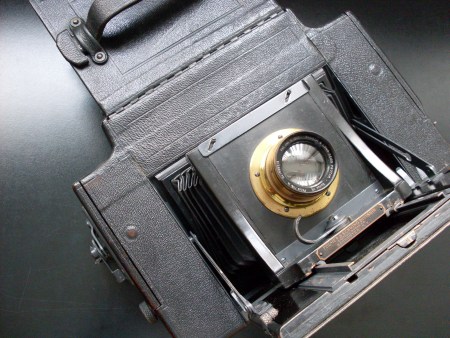
The fabulous 3A Graflex in perfect working condition one century after its manufacturing.
The 3A Graflex was manufactured by Folmer & Swing, at that time a Division of the Eastman Kodak Company.
From 1907 until 1926 the Graflex 3A was one of the first cameras equipped with
a reflex mirror.
Such cameras were equiped with a ground-glass on top of the camera housing on
which the image from the mirror is projected.
A viewing hood is placed above the ground glass for better viewing without
incoming stray light
The mirror pops up when exposure knob is pressed and the film is being exposed
at the same time.
That means that the focal plane shutter curtain moves from top to bottom with a
horizontal open slit along the film surface.
The incoming light which enters through the lens exposes the film during the
time the slit passes the said film surface.
The 3 1/4 x 5 1/2 Postcard size film in combination with the mirror reflex system,
became very popular with the press, street photographers and war
correspondents.
The curtain was equiped with 4 different sized slits which made it much more
reliable than an adjustable slit such as many German cameras used to have.
The 4 different slits in combination with a 6 different shutter tension
roller,
made it possible to choose between 24 exposure time possibilities.
The first 3 A Graflex series distinguish from the later model only by an offset in the rear of the body under the film track and the lack of the autographic feature*.
As from 1915 the 3A was equiped with a so called
Autographic Back which enabled the
photographer to write info on each negative, was made until 1926.
All the advantages of a reflex camera, the very reliable shutter, the rigid
construction and the availability of the 122 film 3 1/4 x 5 1/2,
made it
possible that the Graflex 3A camera had a remarkable long life span of nearly
20 years.
The construction of this very rigid camera, which is made from lock
jointed mahogany, covered with Persian Morocco leather
is more or less comparable with the 10 years later launched
Compact Camera.
Main differences were a third safety curtain and the lack of both film
compartments left and right of the camera housing.
The Graflex 3 A design
created a surplus space on each side of the camera converted into film storage pockets, each carrying two rolls of film.
The lower
spring loaded roller of the horizontal
focal plane shutter was ingeniously placed under the mirror case thus reducing the height of the camera house.
Dimensions: 10¼ x 5 x 6 ½ inch. Lens board measures 3 ¼ x 3 ¼ inch. Minimum focus of lens accommodated 6 ¼ inch.
The construction of the back does not allow the use of film holders in any
way. Just 122 Roll Film can be used.
The overall condition of my 100 years old camera proves that the 3A is all together
a solid and very reliable camera.
The focal plane shutter still works perfectly after 100 years without any repairing, cleaning or lubrication
what so ever.
However, I assume that many of such cameras were not so lucky and stored away
with a fully tensioned spring, eventual in very bad conditions such as in
moistly cellars of hot attics.
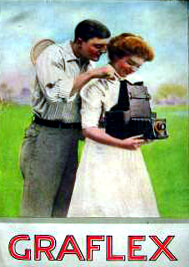
How to open the Camera.
The focusing hood opens automatically if the
top-cover of the camera is raised.
Lock the hood using the side brackets.
On top of the hood, soft velvet shaped to fit the contour of the face of the photographer
and thus excluding extraneous light,
enabling the operator to focus perfectly.
Now open the front door by pushing the hidden knob on top of the right film
compartment.
The door opens but needs to be pushed down until it "clicks"
Pull the lens standard with lens out of the camera housing until the infinity
stop on the end of the track.
Attention,
First pull lens out of the camera house against infinity stop
before setting the controls.
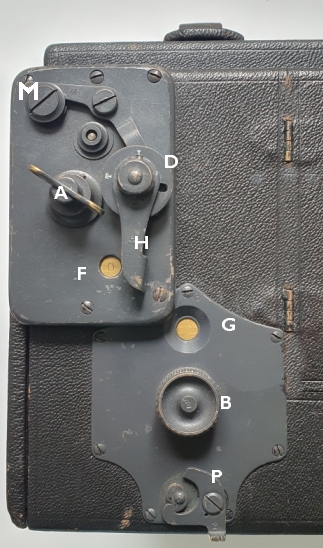
To open the camera press the hidden knob on top of the lower
left side on top of the camera. (Seen from the front side of the
camera).
The hinged bed door opens automatically. Pull the bed
down until the bed braces snap into the full locked position.
Swing the front
standard lock out straight and pull the front firmly against the infinity
stops and lock this position by turning the standard lock to the left.
To open
the focusing hood press the spring catch forward. The hood unfolds
automatically, but you have to lock the two braces to hold the
hood in open position.
Set the mirror by pressing lever H
until it locks. You may now see an image on the ground glass.
Now turn the
focusing knob on the lefts side of the bed backwards or forwards until the
desired object is sharply defined on the screen.
For aperture and diaphragm
setting see Instantaneous Exposure.
To close the camera, please be sure that you first press the
mirror lever H until it locks.
Now swing the standard lock straight and push
the standard all the way back into the camera body.
You may help a bit by
pressing the mirror lever H a bit more to allow
the standard and bellows to find enough space behind the bed door.
Swing the
front standard lock to the left to lock the standard. Make sure the sliding
track is moved all the way back.
Press down the braces and close the hinged
bed door.
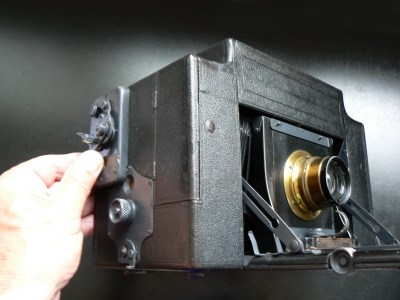
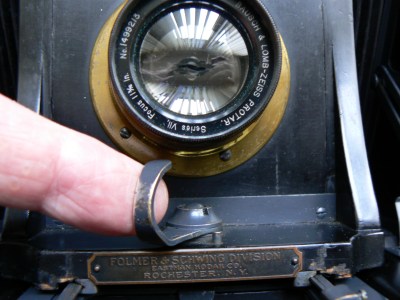
pull lens out of the camera against infinity stop and lock it in that position

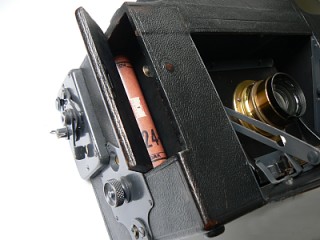
The Film No. A-122.
The wide body included two compartments for storage of each two
films.
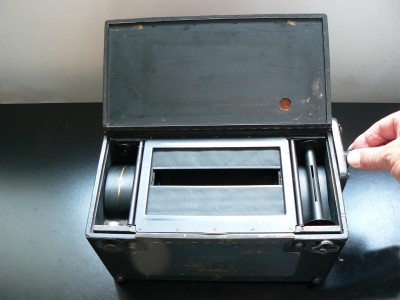
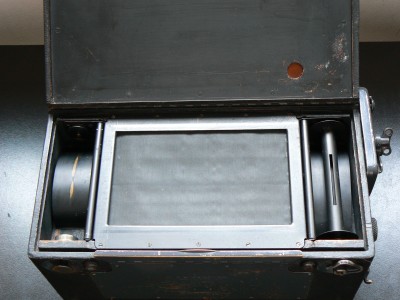
The hinged cover when opened gives easy access to the film compartments.
Watch and see the working of the horizontal slit focal plane shutter which
moves vertical along the film surface..
On both sides of the camera back you'll find a blade shaped spring which keeps
the roll film tide on the spool,
which greatly facilitates loading and unloading the film spool in or out the
camera film compartment.
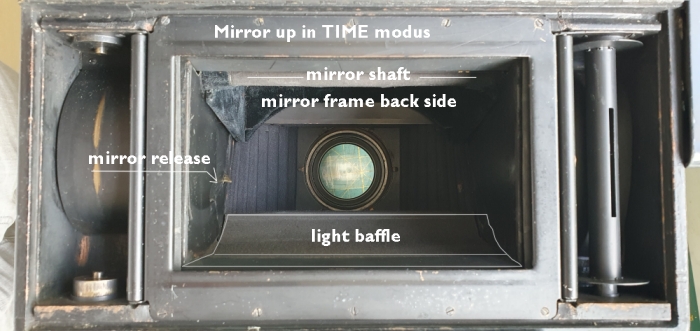
The opened back of the Graflex 3A shows the mirror house in Time exposure
position.
That means that the mirror in this situation is flipped up against the mirror.
No image can be thrown on the ground glass.
Instant modus.

If the mirror is in down position, thus in Instant setting, the entire mirror
house behind the mirror is completely dark
to protect the film for unwanted light and waiting for exposure by the release
button.
The release catch holds the mirror in down position until the release knob will be
activated.
The exposure chamber
fig 8
Above figure shows the mirror in 45 degree focusing position.
Special attention for the double flexible suspension light baffle.
An identical but single suspension assembly was used in the Graflex 1-A.

The downwards moving releasing arm with its slant end 39 moves the
horizontal release arm to the right.

Above the backside of the lens section including the bellows and lens plate.
This section houses the hinged mirror frame with on top the reflex mirror.
LB is a new made light baffle
with on its top the mirror frame catch. See fig 8
This part replaces a worn and broken original. The light baffle will later be covered
with black lining.
On the left side the R thoroughly cleaned
release button assembly. See also Fig 9.
The push arrow moves the release arm to the right and unlocks the mirror with
catch 27 .
SLB stands for Side Light
Baffle. Once assembled again, these thin metal shields are situated between camera wall and exposure chamber.
Together
with the Light Baffle and
the mirror frame, they secure a light proof exposure chamber.
If the release button is pressed, the mirror pops up and at the same time the
focal plane shutter
starts its journey along the film to expose it with its pre-set slit.
Patent. figure 1 shows camera in open position. Focusing image on ground
glass and ready to take an exposure.
Red is mirror. Blue is spring.
Improved Mirror Spring


The big bushing of the mirror shaft holds the mirror under pressure while the small
bushing holds the upper curtain roller in position.
Both features are part of the later produced 3A Graflex model. Visible inside
the film spool storage pocket.
3-A Camera Patented by William F Folmer
Almost identical design like the Compact Graflex, all be it that the 3 A lacks
the safety curtain.
In stead of a third safety blind, the mirror (17) combined with the light baffle (68) keeps the exposure
chamber light tight during
the exposure time setting.
The Instantaneous Exposure
The focal plane shutter gives instantaneous exposures of 1/10 to
1/1000 of a second as well as time exposures of any duration.
Not forgetting to mention that the shutter is equipped with a safety device which prevents winding the shutter until the mirror is set.
The focal plane shutter is the very same as we can find on all the other Graflex cameras of that time.
Apart from the O = "open" setting for time exposures, the curtain contains 4
different slits.
These represents the width of the 4 curtain apertures. The first one is 1½ inch, the
second ¾ of an inch the next 3/8 of an inch and the fastest aperture is 1/8 of an inch.
The Graflex Speed table mounted on the viewing hood shows instantly the speeds obtained with the different tensions and the various apertures.
6 spring tensions combined with the 4 openings or slits gives a total of 24 different
exposure times.
The narrower the slit which moves across the film surface, the shorter the exposure.
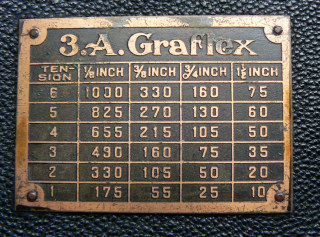
Any exposure time you want is available.
To make a time exposure: Set the mirror.
Turn the I-T disk in such a way that the T is opposite the mark on H.
In the newer model with the Autographic, slide the bar to the marked position
T
Now the mirror is no longer connected to the release.
Turn the winding key until "T" is visible in the window.
Set tension at least on 4. Now focus to your subject.
Set the
diaphragm. To take the photo: Raise the mirror by pressing down the release lever on the left side.
Now the mirror pops up. By pressing down the lever M located on top of the upper control panel, the curtain is pulled down and the full opening exposes the film.
By
pressing down the lever again, the curtain
is drawn down, covers the film and thus ends
the exposure time.
Slow Instantaneous exposure.
Automatic exposures of approximately one fifth of a second can be made.
To do this. Set the mirror and set the curtain at O (open) and the tension at 5.
Now by pressing the release knob at the left front side of the camera,
the mirror will rise up and start the exposure at the same time
allowing the curtain to terminate the exposure.
The following lenses were available with the 3A Camera:
Zeiss Kodak f 6,3 no. 4 - Bausch & Lomb Zeiss Tessar Series Ic f= 4,5 -
Cooke Lens Series II f=4,5. No. 21 1/2.
Comparing to the camera, the lenses were very expensive.
The price of the camera without lens was $ 75.00 lenses
from 101.00 for the Kodak to 125.00 $ each for the B&L and Cooke (catalogue 1914)
* Graflex Autographic Feature
Graflex 1 A back side equiped with Autographic feature.
Note: the aperture back is closed with a removable cover that has an
autographic feature which when opened by a sliding mechanism, enables
to write
location or names onto the film-back paper. Using a metal stylus
the text was written on a kind of typewriter carbon paper.
After developing the film, the written text became visible on the
negative after developing.
George Eastman purchased this invention from Henry J. Gaisman and paid
300.000 US$ for it. Kodak used this new invention in all its so called
Autographic cameras.
Being part of the Eastman company, Folmer & Swing's 1 A Graflex
camera was equipped with the Autographic feature as well.


Photos © Jo Lommen